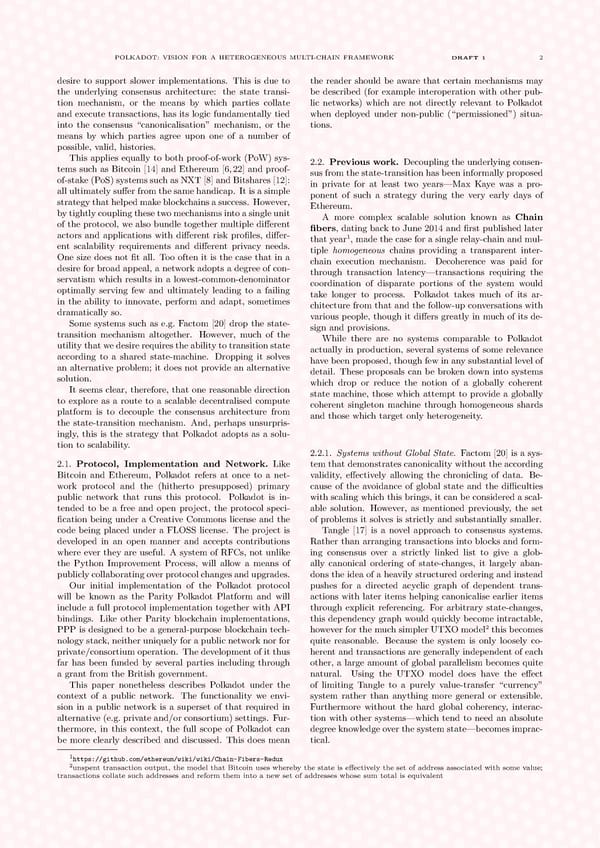POLKADOT: VISION FOR A HETEROGENEOUS MULTI-CHAIN FRAMEWORK DRAFT 1 2 desire to support slower implementations. This is due to the reader should be aware that certain mechanisms may the underlying consensus architecture: the state transi- be described (for example interoperation with other pub- tion mechanism, or the means by which parties collate lic networks) which are not directly relevant to Polkadot and execute transactions, has its logic fundamentally tied when deployed under non-public (“permissioned”) situa- into the consensus “canonicalisation” mechanism, or the tions. means by which parties agree upon one of a number of possible, valid, histories. This applies equally to both proof-of-work (PoW) sys- 2.2. Previous work. Decoupling the underlying consen- tems such as Bitcoin [14] and Ethereum [6,22] and proof- sus from the state-transition has been informally proposed of-stake (PoS) systems such as NXT [8] and Bitshares [12]: in private for at least two years—Max Kaye was a pro- all ultimately suffer from the same handicap. It is a simple ponent of such a strategy during the very early days of strategy that helped makeblockchainsasuccess. However, Ethereum. bytightlycouplingthesetwomechanismsintoasingleunit A more complex scalable solution known as Chain of the protocol, we also bundle together multiple different fibers, dating back to June 2014 and first published later actors and applications with different risk profiles, differ- 1 that year , made the case for a single relay-chain and mul- ent scalability requirements and different privacy needs. tiple homogeneous chains providing a transparent inter- One size does not fit all. Too often it is the case that in a chain execution mechanism. Decoherence was paid for desire for broad appeal, a network adopts a degree of con- through transaction latency—transactions requiring the servatism which results in a lowest-common-denominator coordination of disparate portions of the system would optimally serving few and ultimately leading to a failing take longer to process. Polkadot takes much of its ar- in the ability to innovate, perform and adapt, sometimes chitecture from that and the follow-up conversations with dramatically so. various people, though it differs greatly in much of its de- Some systems such as e.g. Factom [20] drop the state- sign and provisions. transition mechanism altogether. However, much of the While there are no systems comparable to Polkadot utility that we desire requires the ability to transition state actually in production, several systems of some relevance according to a shared state-machine. Dropping it solves have been proposed, though few in any substantial level of an alternative problem; it does not provide an alternative detail. These proposals can be broken down into systems solution. which drop or reduce the notion of a globally coherent It seems clear, therefore, that one reasonable direction state machine, those which attempt to provide a globally to explore as a route to a scalable decentralised compute coherent singleton machine through homogeneous shards platform is to decouple the consensus architecture from and those which target only heterogeneity. the state-transition mechanism. And, perhaps unsurpris- ingly, this is the strategy that Polkadot adopts as a solu- tion to scalability. 2.2.1. Systems without Global State. Factom [20] is a sys- 2.1. Protocol, Implementation and Network. Like temthatdemonstrates canonicality without the according Bitcoin and Ethereum, Polkadot refers at once to a net- validity, effectively allowing the chronicling of data. Be- work protocol and the (hitherto presupposed) primary cause of the avoidance of global state and the difficulties public network that runs this protocol. Polkadot is in- with scaling which this brings, it can be considered a scal- tended to be a free and open project, the protocol speci- able solution. However, as mentioned previously, the set fication being under a Creative Commons license and the of problems it solves is strictly and substantially smaller. code being placed under a FLOSS license. The project is Tangle [17] is a novel approach to consensus systems. developed in an open manner and accepts contributions Rather than arranging transactions into blocks and form- where ever they are useful. A system of RFCs, not unlike ing consensus over a strictly linked list to give a glob- the Python Improvement Process, will allow a means of ally canonical ordering of state-changes, it largely aban- publicly collaborating over protocol changes and upgrades. dons the idea of a heavily structured ordering and instead Our initial implementation of the Polkadot protocol pushes for a directed acyclic graph of dependent trans- will be known as the Parity Polkadot Platform and will actions with later items helping canonicalise earlier items include a full protocol implementation together with API through explicit referencing. For arbitrary state-changes, bindings. Like other Parity blockchain implementations, this dependency graph would quickly become intractable, 2 PPPis designed to be a general-purpose blockchain tech- however for the much simpler UTXO model this becomes nology stack, neither uniquely for a public network nor for quite reasonable. Because the system is only loosely co- private/consortium operation. The development of it thus herent and transactions are generally independent of each far has been funded by several parties including through other, a large amount of global parallelism becomes quite a grant from the British government. natural. Using the UTXO model does have the effect This paper nonetheless describes Polkadot under the of limiting Tangle to a purely value-transfer “currency” context of a public network. The functionality we envi- system rather than anything more general or extensible. sion in a public network is a superset of that required in Furthermore without the hard global coherency, interac- alternative (e.g. private and/or consortium) settings. Fur- tion with other systems—which tend to need an absolute thermore, in this context, the full scope of Polkadot can degree knowledge over the system state—becomes imprac- be more clearly described and discussed. This does mean tical. 1 https://github.com/ethereum/wiki/wiki/Chain-Fibers-Redux 2unspent transaction output, the model that Bitcoin uses whereby the state is effectively the set of address associated with some value; transactions collate such addresses and reform them into a new set of addresses whose sum total is equivalent
 POLKADOT Page 2 Page 4
POLKADOT Page 2 Page 4